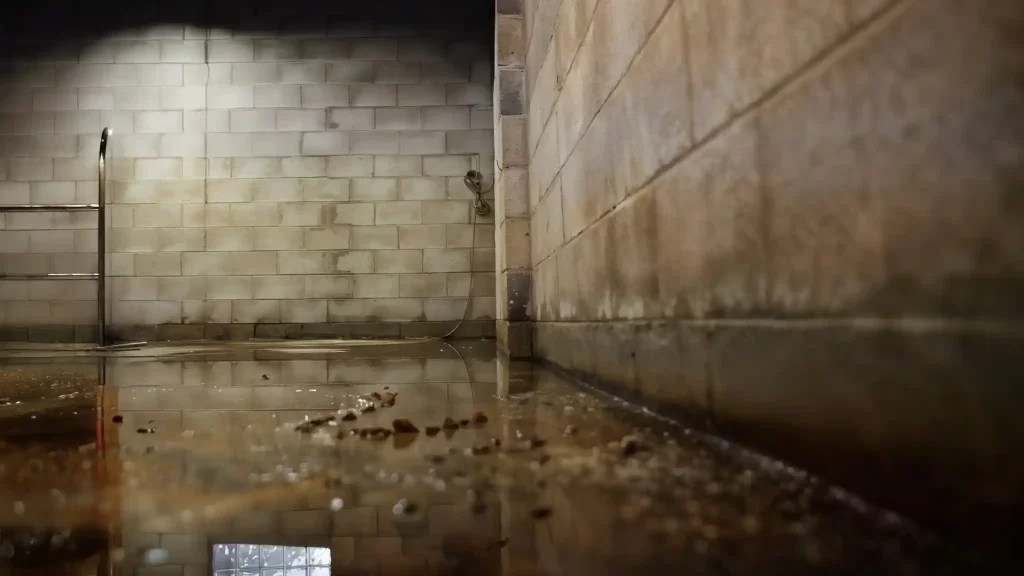Basement flooding is a homeowner’s nightmare. Even just one inch of water can cause significant damage—soaked carpet, ruined boxes of belongings, warped wood, and the start of mold growth. The faster you act, the more likely you’ll minimize damage and avoid costly repairs. In this guide, we’ll walk you through how to safely and effectively remove 1 inch of water from a basement, and why calling in professionals like Semper Fi Restoration can save you time, stress, and money.

Step 1: Prioritize Safety Before Entering
Before rushing in to tackle the water, safety comes first:
- Turn off electricity in the basement at the breaker box. Water and live wires are a deadly combination.
- Check for gas leaks or strange odors. If you smell gas, evacuate immediately and call your utility company.
- Wear protective gear such as waterproof boots, gloves, and a mask. Even an inch of water can carry harmful bacteria or chemicals.
If it feels unsafe at any point, wait for professionals to arrive.
Step 2: Stop the Source of the Water
Removing the water won’t matter if more keeps coming in. Identify where it’s coming from:
- Heavy rain or groundwater seepage – common during storms or when the water table rises.
- Burst pipes or plumbing leaks – shut off the main water supply if necessary.
- Appliance failures – such as a water heater or washing machine leaking.
Addressing the source first ensures your cleanup is effective.
Step 3: Remove the Water Efficiently
With only one inch of water, you don’t need heavy-duty pumps, but speed is key to prevent damage. Here are the best methods:
- Wet/Dry Vacuum – A shop vac is the go-to tool for shallow water removal. Attach the largest hose and empty the collection tank frequently.
- Mop and Bucket – For very small areas, this can work, though it’s time-consuming.
- Portable Utility Pump – If water is spread over a wide area, a small submersible pump can move it out quickly.
Tip: Always direct water discharge away from the foundation to prevent it from cycling back in.
Step 4: Dry Out the Basement
Once the visible water is gone, the real work begins. Moisture left behind can seep into walls, flooring, and furniture. To dry things quickly:
- Use fans and dehumidifiers to circulate air and pull moisture out.
- Open windows if weather permits, to aid ventilation.
- Remove porous materials like carpet, padding, cardboard boxes, and fabric furniture—they’re breeding grounds for mold.
- Disinfect surfaces with a bleach solution or commercial cleaner to kill bacteria.
The drying stage is critical. Even if it looks dry, hidden moisture can cause long-term problems.
Step 5: Prevent Mold Growth
Mold can begin developing within 24–48 hours of water exposure. To prevent this:
- Keep humidity levels below 50% with a dehumidifier.
- Treat affected surfaces with antimicrobial solutions.
- Monitor for musty odors, discoloration, or fuzzy patches on walls and floors.
If mold does appear, call in experts immediately. DIY removal can spread spores and worsen the problem.
Step 6: Call the Professionals When Needed
While minor water incidents may be manageable, basements are tricky spaces. Even an inch of water can seep under flooring, into insulation, and behind walls—places you can’t easily see or reach. That’s why homeowners often turn to experts like Semper Fi Restoration.
Why Choose Semper Fi Restoration?
- Rapid Response – They understand that every hour counts in preventing damage.
- Advanced Equipment – Industrial-grade pumps, air movers, and dehumidifiers get your basement dry faster than consumer tools.
- Expertise – Their technicians know how to spot hidden damage, prevent mold, and restore your space fully.
- Peace of Mind – Instead of worrying about lingering moisture or future mold, you’ll know the job was done right.
By bringing in Semper Fi Restoration, you’re not just cleaning up water—you’re protecting your home’s long-term health and value.
Preventing Future Basement Water Issues
After cleanup, it’s wise to take preventative measures:
- Install a sump pump with a backup battery system.
- Seal foundation cracks and inspect for weak points.
- Ensure gutters and downspouts direct water away from the house.
- Consider a basement waterproofing system if flooding is recurrent.
These steps reduce the chance of dealing with another stressful incident.
Final Thoughts
Even just an inch of water in your basement is more than an inconvenience—it’s a risk to your home’s structure, your belongings, and your family’s health. Acting quickly, removing the water safely, and thoroughly drying the space are essential. For complete peace of mind, trust Semper Fi Restoration, a premier water damage restoration company dedicated to helping homeowners recover quickly and safely.
Don’t wait until the next storm or plumbing failure catches you off guard. Be prepared, act fast, and call in the professionals when needed.
FAQ
1. Is one inch of water in my basement really a big deal?
Yes. Even one inch of water can damage flooring, drywall, insulation, and belongings. More importantly, it creates a damp environment where mold can start growing within 24–48 hours.
2. What is the fastest way to remove 1 inch of water from a basement?
The quickest option is a wet/dry shop vacuum or a portable utility pump. Both are efficient for shallow water. For larger areas or continuous leaks, professionals like Semper Fi Restoration use industrial equipment that works even faster.
3. Is it safe to enter a basement with standing water?
Not until you’ve shut off electricity to the basement at the breaker. Water and live wiring are extremely dangerous. Always prioritize safety and wear protective boots and gloves before entering.
4. Can I dry the basement myself, or do I need professionals?
You can handle small water incidents with fans, dehumidifiers, and disinfectants. However, water can seep into hidden areas you may not notice. Calling professionals like Semper Fi Restoration ensures no moisture or mold is left behind.
5. How long does it take to dry a basement after water removal?
It depends on the size of the basement and how saturated materials are. With fans and dehumidifiers, light flooding may dry in 24–48 hours. Severe cases could take several days or more without professional equipment.
6. Will insurance cover basement water damage?
It depends on the cause. Burst pipes or appliance leaks are often covered, while groundwater seepage or flooding usually requires separate flood insurance. Review your policy and contact your insurance company promptly.
7. What should I throw away after basement flooding?
Porous items like carpet, padding, cardboard boxes, mattresses, and upholstered furniture should usually be discarded, as they trap bacteria and mold. Non-porous items (plastic, metal, glass) can often be cleaned and disinfected.
8. How can I prevent mold after a basement flood?
Dry the area thoroughly within 24–48 hours, run a dehumidifier, and disinfect affected surfaces. If mold spots or musty odors develop, call a professional remediation team like Semper Fi Restoration immediately.
9. How can I stop my basement from flooding again?
Install a sump pump with backup power, keep gutters clean, extend downspouts away from the foundation, and seal cracks in basement walls. Professional waterproofing systems can also provide long-term protection.
10. When should I call a professional restoration company?
If the water covers more than a small area, has soaked into walls or flooring, or if you notice any signs of mold, it’s best to call experts. Semper Fi Restoration has the tools, training, and experience to restore your basement quickly and safely.


